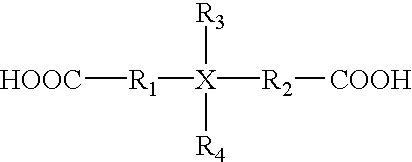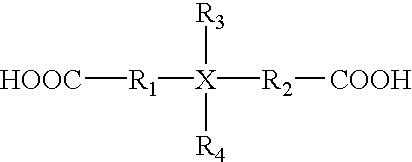Polyester water-based defoamer
a water-based degasification and polymer technology, applied in the direction of liquid degasification, pulping foam prevention, separation processes, etc., can solve the problems of microemulsions presenting fire danger, oil/alcohol presence is quite undesirable, and foam in pulping operations
- Summary
- Abstract
- Description
- Claims
- Application Information
AI Technical Summary
Problems solved by technology
Method used
Image
Examples
example 2
To evaluate the polymer of Example 1 as a defoamer in comparison with a polyethylene glycol fatty acid concentrate, a foam cell tester was used. The foam cell tester uses a graduated glass cylinder incremented every 0.5 cm for 30 cm with the bottom of the cylinder fitted with a piece of rubber tubing attached to a steel pipe leading to a centrifugal pump. Another piece of piping, with an aspirator led out of the top of the pump and into the top of the cylinder.
Black liquor from the first stage filtrate of Union Camp's Savannah, Ga, plant was diluted in tap water to 2.0%. The 2.0% black liquor was heated to 120.degree. F. and poured into the glass cylinder to 15 cm. The pump was connected to a rheostat which was set at 65%. Using a micropipettor, 60 microliters of the concentrate was carefully dropped onto the surface of the dilute black liquor. The foam cell was turned on and the 2.0% black liquor was sucked into the pump and circulated into the top of the glass cylinder creating fo...
example 3
The procedures of Examples 1 and 2 were repeated to prepare and evaluate a series of different polyesters for their defoaming capacity. The polyesters prepared were as in Example 1 except, that in Defoamer A there was only dimer acid and no oleic acid; in Defoamer B the amount of the PPG-2000 was increased to 0.6 moles and the amount of the PEG-400 was decreased to 0.4 moles; for Defoamer C all of the PPG-2000 was replaced by PEG-400; and for Defoamer D the PEG-400 was replaced with a higher molecular weight PEG-600.
example 4
Another 650 g batch of polyester was prepared as in Example 1 but using reacting 0.7 moles of the dimer fatty acid and 0.4 moles of oleiciacid with 0.7 moles PPG-2000 and 0.3 moles of PEG-400. To improve the color, 0.1% hypophosphorous acid, 50%, was added. The final polyester was slightly hazy and had a light amber color. The viscosity was 4400 cps as measured by a Brookfield Viscometer.
250 g of the water-based defoamer was prepared. 183.75 g of tap water at 90.degree. F. was charged into a 400 ml beaker. Using a Lightning Mixer with metal shaft and metal mixing blade, stirring of the water began. 27.5 g of the polyester from Ex. 4 and 12.5 g of the polyester from Ex. 1 were charged into the beaker. The polymers were mixed for 15 minutes. 3 g of 30% aqueous solution of a polyacrylic acid was charged followed by 0.75 g of diethanolamine. This was mixed for 45 minutes.
The final product was a 16% active, opaque, off-white macroemulsion with a viscosity of 410 cps as measured by a Broo...
PUM
| Property | Measurement | Unit |
|---|---|---|
| Time | aaaaa | aaaaa |
| Percent by mass | aaaaa | aaaaa |
| Percent by mass | aaaaa | aaaaa |
Abstract
Description
Claims
Application Information
 Login to View More
Login to View More - R&D
- Intellectual Property
- Life Sciences
- Materials
- Tech Scout
- Unparalleled Data Quality
- Higher Quality Content
- 60% Fewer Hallucinations
Browse by: Latest US Patents, China's latest patents, Technical Efficacy Thesaurus, Application Domain, Technology Topic, Popular Technical Reports.
© 2025 PatSnap. All rights reserved.Legal|Privacy policy|Modern Slavery Act Transparency Statement|Sitemap|About US| Contact US: help@patsnap.com



